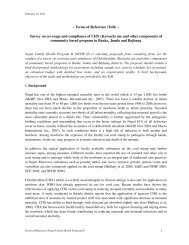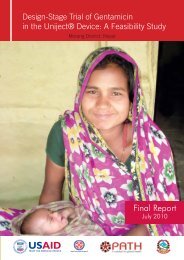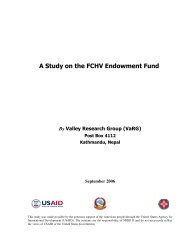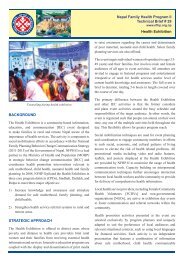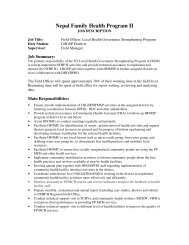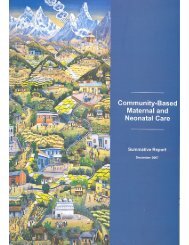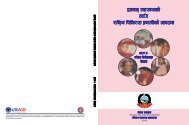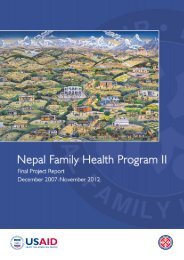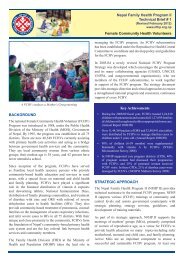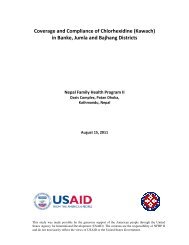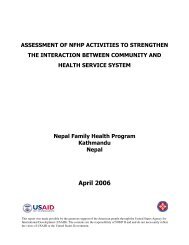Nepal Family Health Program II Technical Brief #17
Nepal Family Health Program II Technical Brief #17
Nepal Family Health Program II Technical Brief #17
Create successful ePaper yourself
Turn your PDF publications into a flip-book with our unique Google optimized e-Paper software.
<strong>Nepal</strong> <strong>Family</strong> <strong>Health</strong> <strong>Program</strong> <strong>II</strong><br />
<strong>Technical</strong> <strong>Brief</strong> <strong>#17</strong><br />
(Revised December 2009)<br />
<strong>Health</strong> Facility Management Strengthening <strong>Program</strong><br />
Participatory game for team building among members of the<br />
<strong>Health</strong> Facility Operation and Management Committee.<br />
BACKGROUND<br />
The foundation of any effective health program is<br />
engaged members of the community. They are<br />
important as users, in mobilizing local resources, and<br />
reaching out to segments of the population which have<br />
not benefited from existing services. Communities have<br />
a right to quality health care and, at the same time, a<br />
responsibility to support government efforts in<br />
developing more effective community health services.<br />
The vision of the Government of <strong>Nepal</strong> (GoN) for<br />
health and development focuses on self-reliance,<br />
community participation, and involvement of the<br />
private sector and nongovernmental organizations<br />
(NGOs). In 1999, the government passed the Local<br />
Self-Governance Act, based on which the Ministry of<br />
<strong>Health</strong> and Population (MoHP) decided to decentralize<br />
health service management to local bodies1. The<br />
intention of this initiative was to encourage local<br />
communities to take greater responsibility in managing<br />
local health facilities and health programs.<br />
Since its beginning in late 2001, the <strong>Nepal</strong> <strong>Family</strong><br />
<strong>Health</strong> <strong>Program</strong> (NFHP) has been involved in<br />
strengthening the interface between communities and<br />
health facilities (HFs) and service providers. This<br />
support has enabled the community to be more involved<br />
in managing their health programs and services and<br />
thus benefit from local health services.<br />
During 2003/04-2004/052, NFHP, mainly through its<br />
partners, Save the Children, US (SC/US) and CARE-<br />
<strong>Nepal</strong>, provided support to GoN in the initial formal<br />
hand-over of health facilities to their communities in its<br />
17 core program districts (CPDs). Nationwide, this<br />
process was initiated in 2002/03, and by during<br />
2005/063 was completed in 28 districts and involved<br />
1433 HFs. Approximately half of these (736) were<br />
supported by NFHP. Following this formal process,<br />
during 2004-2006 three-day capacity assessments and<br />
strengthening trainings were given to 502 members of<br />
these new <strong>Health</strong> Facility Operation and Management<br />
Committee (HFOMC). In most of these cases (422),<br />
support provided from 2002-20063 also involved use of<br />
the “partner defined quality” approach. This process<br />
involved assessing quality issues from the perspective<br />
of both HFs and the community and then jointly<br />
prioritizing and developing action plans. Through these<br />
inputs, NFHP sought to empower local communities to<br />
manage health services at the community level and<br />
strengthen the partnership between the community and<br />
the HF.<br />
In 2006, NFHP assessed its input in this area over the<br />
first five years of the project and learned key lessons4, 5.<br />
• Community members (including HFOMC<br />
members and HF staff) were generally not adequately<br />
informed to take up these new roles as envisioned by<br />
the new government policy. Lack of clarity on the<br />
expected functions, roles and responsibilities of various<br />
players e.g., Village Development Committee (VDC),<br />
District Development Committee (DDC) and District<br />
(Public) <strong>Health</strong> Office (D(P)HO) resulted in some<br />
confusion.<br />
• Mere ‘hand-over’ of HFs to local bodies did not<br />
ensure achievement of the objectives of this initiative.<br />
Once HFOMC members were provided with support,<br />
enhancing knowledge, skills, and motivation, they were<br />
able to manage their HFs more effectively.<br />
• The hand-over process and strengthening <strong>Program</strong><br />
and other community mobilization initiatives need to be<br />
understood and implemented as a process not merely as<br />
a series of events.<br />
• Active linkages between DDCs, D(P)HOs, VDCs<br />
and HFOMCs are indispensable for mobilization of<br />
local resources.<br />
• HFOMCs require technical guidance if they are to<br />
focus to improving health (and health pro-grams) rather<br />
than focusing only on developing physical<br />
infrastructure.<br />
• HFMOC need support and confidence- building<br />
to effectively support dalit and janjatis (highly<br />
marginalized / disadvantaged peoples) and women.
<strong>Program</strong>s and activities implemented under different<br />
names by different organizations were working in<br />
isolation. Consolidating efforts and developing an<br />
effective common capacity building package have<br />
helped to improve and streamline services.<br />
In close cooperation with National <strong>Health</strong> Training<br />
Centre (NHTC) and other stakeholders engaged in<br />
capacity building of local health facilities, NFHP<br />
further refined its approach and in 2007 developed a<br />
modified approach called Community and <strong>Health</strong><br />
Facility as Partners (CHFP) which was implemented in<br />
8 core program districts. NFHP studies and lessons<br />
have been instrumental for this refinement.<br />
Under the <strong>Nepal</strong> <strong>Family</strong> <strong>Health</strong> <strong>Program</strong> <strong>II</strong> (NFHP <strong>II</strong>),<br />
the CHFP approach has been continuously refined. In<br />
2009, NFHP <strong>II</strong> changed the name of the program to the<br />
<strong>Health</strong> Facility Management Strengthening <strong>Program</strong><br />
(HFMSP) to reflect more accurately the program’s<br />
goals. As of late 2009, NFHP <strong>II</strong> has provided direct<br />
HFMSP support in four CPDs (Banke, Dang, Surkhet,<br />
Kanchanpur), covering 65 HFs, with full district<br />
coverage in Kanchanpur. NFHP <strong>II</strong> provides support to<br />
HFOMCs in the remaining CPDs through other<br />
organizations.<br />
STRATEGIC APPROACH<br />
<strong>Health</strong> Facility Management Strengthening <strong>Program</strong><br />
NFHP <strong>II</strong>’s HFMSP approach seeks to improve the<br />
health of the community (with special focus on<br />
marginalized and underserved people) by empowering<br />
community members to manage their local HFs and<br />
other health programs. Key features of this approach<br />
include:<br />
• Increasing community participation in decision -<br />
making in management of local health facilities.<br />
• Involving disadvantaged groups (e.g., dalits) in<br />
health facility management decision-making.<br />
• Delivering a complete package of interventions<br />
to develop knowledge and skills in managing health<br />
facilities, rather than one-time events like trainings.<br />
• Using simple, community friendly tools,<br />
guidelines, and training methods.<br />
HFOMC members develop a social map to identify the dalits<br />
and poor in their community.<br />
• Focusing on building skills in organizational<br />
development, HF management, and health services<br />
provision using a phased-in model.<br />
• Considering ways to scale-up from the very<br />
beginning of the program.<br />
• Involving DDC/DPHO to developing their<br />
leadership in order to institutionalize the HFMSP<br />
approach.<br />
• Sharing results and advocating for HFOMCs<br />
at the central level (i.e., among concerned ministries<br />
and external development partners).<br />
PROCESS<br />
The HFMSP approach involves a two year period of<br />
support (one year intensive implementation and one<br />
year limited technical support) including a three-day<br />
interaction session, periodic review meetings, regular<br />
follow up, and promotional activities. A brief account<br />
of major steps is described below.<br />
Startup Activities<br />
Four districts were selected out of NFHP <strong>II</strong>’s 22 CPDs,<br />
prioritizing those with weaker health services<br />
performance and lower human development index<br />
status. From each district, VDCs were selected for<br />
special focus – 65 in total. After districts and VDCs<br />
were selected, NFHP <strong>II</strong> field officers and D(P)HO staff<br />
were oriented on HFMSP approaches and<br />
tools/guidelines in April-May 2008.<br />
HFOMC Situational Assessments<br />
In June-July 2008, NFHP <strong>II</strong> staff conducted situational<br />
assessments of HFOMCs, HFs, and community groups<br />
involved in HFOMC before implementing the HFMSP<br />
package. The purpose of these assessments was to<br />
understand better HFOMC membership, organizational<br />
capacity, and resource mobilization in each VDC.<br />
Three-day Interaction Meetings with HFOMC<br />
After situational assessment, district and HF staff<br />
conducts three-day interaction trainings for HFOMC<br />
members on HFOMC roles/responsibilities and the<br />
importance of representing and discussing existing<br />
health service problems in HFOMC meetings. Through<br />
training, HFOMC members develop needed skills to<br />
conduct effective meetings and prepare action plans to<br />
respond to problems/issues identified by their group.<br />
Another objective addressed in these meetings include<br />
ways to improve social inclusiveness in access to and<br />
use of health services.<br />
Interaction sessions are designed to be very<br />
participatory and responsive to locally identified needs.<br />
Methods used include discussions and classroom<br />
teaching, and were tailored to the local context.
<strong>Technical</strong> Support Visits<br />
After the three-day interaction sessions, NFHP field<br />
officers, together with D(P)HO staff, conduct monthly<br />
technical support visits (TSV) to observe, coach, and<br />
facilitate meetings of the HFOMC. In these TSVs,<br />
HFMSP staff collects information regarding gaps in<br />
knowledge and skills of HFOMC members necessary to<br />
conduct effective meetings, implement action plans,<br />
and provide supportive supervision and follow-up to<br />
HF staff and HFOMC members.<br />
Review Meetings<br />
Every five months, HFMSP staff also conduct training<br />
sessions to address gaps identified in TSVs. Focus is<br />
placed on increasing knowledge and building skills in<br />
topics including: resource mobilization; program<br />
monitoring and supervision; good governance; VDC<br />
health need assessment and plan; and conducting<br />
visioning activities.<br />
Capacity of Dalit and Women HFOMC Members<br />
Though the current composition of the HFOMC is<br />
intended to be inclusive, dalit and women members<br />
have tended not to actively participate. Therefore,<br />
strengthening the capacity of dalits and women<br />
members is given a high priority through assessment<br />
and coaching.<br />
Community Mobilization Activities<br />
During the three-day interaction meetings, detailed<br />
action plans are prepared. NFHP <strong>II</strong> provides technical<br />
support to HFOMC members to help implement their<br />
identified priority activities. They have tended to focus<br />
mostly on increasing use of services by those who are<br />
underserved. HFMSP staff also conducts HFOMC<br />
promotional activities in order to create awareness<br />
among community members about the function of<br />
HFOMCs, the roles and responsibilities of HFOMC<br />
members, and the variety of services available at their<br />
HFs.<br />
Advocacy Meeting at District Level<br />
Advocacy programs with DDC and VDC secretaries are<br />
organized semi-annually to update them on HFMSP<br />
progress, as well as to advocate for: resource<br />
mobilization for local health services; increased<br />
supervision, monitoring, and support to HFOMCs; and<br />
increased linkages between the VDC, DDC, D(P)HO,<br />
and HFOMC.<br />
Progress monitoring and Next Steps<br />
At the end of intensive HFMSP implementation year,<br />
an assessment will be done in order to assess the status<br />
of HFMSP-supported HFOMCs and to facilitate<br />
development of strategies for future technical support<br />
(but more limited).<br />
RESULTS<br />
Key HFMSP results till September 20096 include:<br />
• Regularity of HFOMC monthly meetings has<br />
increased from 32% in June-July 2008 to 78% in<br />
September 2009 (see Figure 1). The effectiveness of<br />
these meetings has also increased (from 0% to 44%), as<br />
measured by the occurrence of activities such as: issue<br />
identification and prioritization, problem root cause<br />
analysis, and action plan development.<br />
• In more than 50% of VDCs, HFOMC have<br />
regular meeting with development and execution of<br />
action plan on their own with very limited technical<br />
support<br />
• HFOMC priorities have shifted from basic<br />
infrastructure/medicine issues to more sophisticated<br />
service and program-related issues.<br />
• Participation in HFMOC meetings by at least<br />
one dalit member has increased to 72%, from 34% at<br />
Percent<br />
100<br />
90<br />
80<br />
70<br />
60<br />
50<br />
40<br />
30<br />
20<br />
10<br />
0<br />
32<br />
baseline.<br />
• HFOMCs are now actively involved in hiring<br />
and motivating staff members, mobilizing resources,<br />
planning infrastructure, and managing services. Within<br />
one year of the program, HFOMCs mobilized more<br />
than ten million rupees in 55 program VDCs.<br />
• Client utilization of key family planning and<br />
maternal and child health services increased in 56% of<br />
HFMSP-supported HFs.<br />
• Dalit proportion among all HF clients vs Dalit<br />
proportion among catchment population has increased<br />
to 1.41 from the baseline 0.70. In other words, use of<br />
health services by “Dalits” is 1.4 higher than their share<br />
in the total population of the program VDCs.<br />
LESSONS LEARNED<br />
Figure 1. HFOMC Meeting Activities<br />
78<br />
Meetings are held<br />
regularly<br />
0 0<br />
• Local bodies can take longer than<br />
anticipated to pick up all the functions envisioned<br />
under decentralization. To help facilitate this process,<br />
expected roles need to be clearly communicated,<br />
support is needed to build capacity, and the process<br />
must be regularly monitored during the initial phase.<br />
Decentralization needs to be understood and<br />
implemented as an ongoing process rather than an<br />
event.<br />
44<br />
Meetings are effective<br />
June-July 2008<br />
Sep-09<br />
65<br />
Action plan is developed
• <strong>Health</strong> facilities need on-going support after<br />
decentralization. DDCs, VDCs, and municipalities<br />
generally have not given sufficient support to HFs once<br />
they have been handed over to local bodies. There is a<br />
need to further develop capacity of these local bodies.<br />
• A continuous focus on quality is critical. Most<br />
HFOMC meetings have focused on issues of drug<br />
purchase, infrastructure development and human<br />
resources. Important as these issues may be, they have<br />
overshadowed health programs and provision of quality<br />
health care services.<br />
Developing a Vision through Training:<br />
Vision Statement of Ghumkhare HFOMC,<br />
Surkhet<br />
By 2012, the HFOMC will be able to do the<br />
following things:<br />
• Hold regular monthly meeting;<br />
• Collect issues from communities and share the<br />
decision of meeting with community people;<br />
• VDC will have own health sector plan;<br />
• Fill vacant staff positions and conduct staff<br />
motivation activities;<br />
• Activities related to FCHV motivation;<br />
• All community people will be made aware of HF<br />
services;<br />
• Identify communities not using HF services and<br />
do activities to increase use;<br />
• Increase coverage of health services<br />
(immunization, delivery by health workers)<br />
which are low;<br />
• Improve HF environment (compound wall,<br />
garden, drinking water).<br />
• Targeted support for marginalized populations is<br />
key. Regular coaching for dalits and female members<br />
on their roles and responsibilities has been very<br />
productive. The duration of such capacity building<br />
measures needs to be increased.<br />
• Motivated, competent (or having the potentiality<br />
for competency), and inclusive HFOMC committee<br />
members are critical in order to maintain a spirit of<br />
active voluntarism and group empowerment.<br />
• Self-assessment by HFOMC is helpful not only in<br />
helping to orient their work, but also in building selfefficacy<br />
thus promoting long-term sustainability.<br />
• Take a step-by-step approach, moving from<br />
simpler activities to more complex ones, in order to<br />
slowly build HFOMC capacity over time. Create<br />
milestones to mark and celebrate small, incremental<br />
achievements.<br />
REFERENCES:<br />
1. National <strong>Health</strong> Training Center. Directives of<br />
<strong>Health</strong> Facility Hadover and Operation, 2060.<br />
2. <strong>Nepal</strong> <strong>Family</strong> <strong>Health</strong> <strong>Program</strong>. End of the project<br />
Document, 2007.<br />
3. Department of <strong>Health</strong> Services. Annual Report,<br />
2005/06.<br />
4. Chataut BD, Gurung G. Assessment of NFHP<br />
activtiies to strengthen the interaction between<br />
community and health service system, 2006.<br />
5. Shrestha IB. Review of activities undertaken by<br />
NFHP and its partners to strengthen the partnership<br />
between Community and <strong>Health</strong> Facilities, 2007.<br />
6. <strong>Nepal</strong> <strong>Family</strong> <strong>Health</strong> <strong>Program</strong>. Semi-annual<br />
Report, 2009.<br />
This technical brief is one of a series seeking to capture key lessons learned from the USAID/ <strong>Nepal</strong> bilateral project,<br />
the <strong>Nepal</strong> <strong>Family</strong> <strong>Health</strong> <strong>Program</strong> <strong>II</strong> (367-A-00-08-00001-00), 2007-2012. The document was produced with support<br />
from the American people through the U.S. Agency for International Development.<br />
The views expressed in this document do not necessarily reflect those of USAID.<br />
The <strong>Nepal</strong> <strong>Family</strong> <strong>Health</strong> <strong>Program</strong> <strong>II</strong> is implemented by JSI Research and Training Institute, Inc. and its partners – Save the<br />
Children, Engender<strong>Health</strong>, Jhpiego, World Education, <strong>Nepal</strong>i <strong>Technical</strong> Assistance Group, <strong>Nepal</strong> Fertility Care Center,<br />
Management Support Services, the <strong>Nepal</strong> Red Cross Society, United Mission to <strong>Nepal</strong>, BBC World Service Trust, Digital<br />
Broadcast Initiative Equal Access <strong>Nepal</strong>, and <strong>Family</strong> Planning Association of <strong>Nepal</strong>.<br />
Office address:<br />
Oasis Complex, Patan Dhoka, P.O.Box 1600 Kathmandu, <strong>Nepal</strong><br />
Tel: 977-1-5524313; Fax: 977-1-552-6608<br />
Website: www.nfhp.org.np



